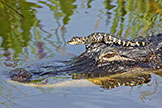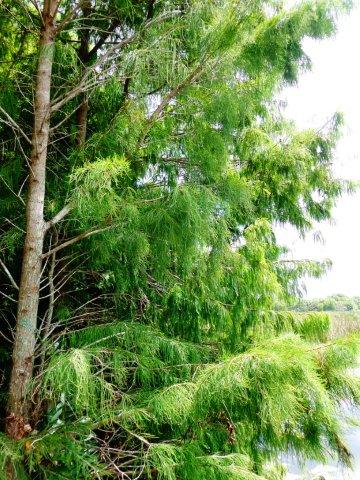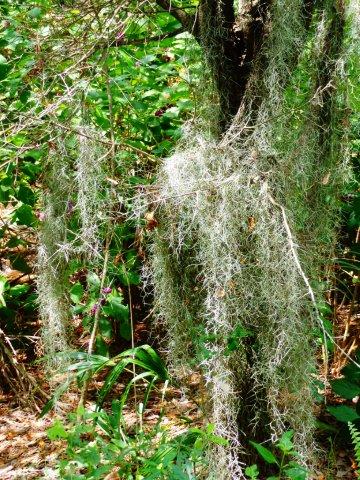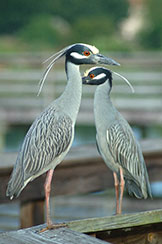QR Zones of Green Cay Wetlands Boardwalk Back to Introduction
 This zone represents an alligator hole, an area that is ubiquitous in the Florida Everglades.  Follow this link to see a video presentation of this zone! Follow this link to see a video presentation of this zone! During the dry season in a wetland, the water soaks into the ground and evaporates faster than the water is replaced, causing much less water in the wetland. Because alligators need water to survive, they go to the deepest part of the marsh and clear out the vegetation and muck from holes using their feet, tail, and snout. Typically, the holes are 10-20 feet in diameter and a few feet deep. When it's dry, these holes will hold water until the rains come again. The holes become an oasis for fish, turtles, frogs, and other animals dependent on water. Survivors repopulate the area when the water levels rise again. Birds and mammals are attracted to the abundant life in the holes, and sometimes become food for the alligators. Because these other animals are dependent on alligators for survival, alligators are called a "keystone species."

ALLIGATOR - Here in Florida, we have 2 species of crocodilians: the American Alligator, and the American Crocodile. Their ranges only overlap in the very southern tip of Florida. American alligators are found in the southeast United States. American alligators live in freshwater environments, such as ponds, marshes, wetlands, rivers, lakes, and swamps, as well as in brackish environments. The type of food eaten by alligators depends upon their age and size. When young, alligators eat fish, insects, snails, crustaceans, and worms. As they mature, progressively larger prey is taken, including larger fish such as gar, turtles, and various mammals, particularly nutria and muskrat, as well as birds, deer, and other reptiles. Alligators are the apex predator in a wetland food chain. They help to keep other animals population in check.

BALD CYPRESS TREE - Often found in swampy settings, particularly in the eastern half of the United States. The tree grows along the banks of creeks, rivers and streams that have slow-moving water and is abundant in the Deep South, according to the University of Florida. The bald cypress is also a habitat in and of itself, providing a home for animals in its trunk and branches and food for them in the form of its seeds. The bald cypress tree can survive for centuries. Growing slowly, the bald cypress will get taller and taller for roughly 200 years, reaching heights of up to 150 feet. The trees usually live for 600 years, though some specimens are said to have survived for more than 1,000 years. Midway through their lives, fungus often besets the bald cypress, beginning at the top of the tree and working its way down.

SPANISH MOSS - Spanish moss is a native, perennial epiphytic herb. It is not Spanish, nor a moss, but a flowering plant. The slender, wiry, long, branching stems (reaching over 20ft) grow as suspended, bluish-gray streamers and garlands draping among tree branches and sometimes telephone lines and fences. The plant is not parasitic, as is often thought, but attaches itself to trees for support. The plant has no roots but derives its nutrients from rainfall, detritus and airborne dust. The stems and leaves are covered with overlapping silver-gray scales, which are important for absorbing water and trapping dust and nutrient particles. Spanish moss has figured largely for generations in North and South American folk medicine traditions as a treatment for a wide variety of medical problems; several of these problems --particularly diabetes and skin conditions -- are believed by many alternative medicine practitioners to be effectively treated by Spanish moss. However, these claims have not been backed by scientific evidence, and Spanish moss use is not advocated by the Food and Drug Administration.

OTTERS - Florida otters have very beautiful brown fur, the male is slightly larger and darker. An otter is about the size of a cat. Otters are very good swimmers which is good because they mostly eat fish. The otter is not a fussy eater. It otter will eat almost anything that swims or floats - fish, frogs, tadpoles, turtles, insects, even ducks and other birds. Perhaps its favorite treats are the crayfish that live on the bottom of rivers and ponds. To find crayfish and other bottom dwellers, the otter dives all the way down and does a handstand. Then it pokes its nose into cracks, its stiff bristly nose whiskers feeling around in these nooks and crannies until they touch something. When this happens, it triggers the nerves in the otter's brain and the otter digs in. The otter usually feeds just after dusk and then again before dawn. 
CYPRESS KNEES - A cypress knee is a term used in the biology of trees to describe the distinctive structures forming above the roots of a cypress tree. Their function is unknown, but they are generally seen on trees growing in swamps. Some scientists have thought they may help in oxygenation to the tree's roots or assist in anchoring the tree in the soft, muddy soil. Knees are woody projections sent above the normal water level, roughly vertically from the roots. One early assumption of their function was that they provided oxygen to the roots that grow in the low dissolved oxygen waters typical of a swamp. There is little actual evidence for this assertion; in fact, swamp-dwelling specimens whose knees are removed continue to thrive, and laboratory tests demonstrate that the knees are not effective at depleting oxygen in a sealed chamber. Another more likely function is that of structural support and stabilization.

YELLOW CROWNED NIGHT HERON - Yellow Crowned Night Herons occur along the shores of wetlands in the southern tips of Florida and Texas and all throughout Central and South America. This bird will roost and feed in both fresh and saltwater wetlands. True to its name, this bird is often seen roosting during the day and is more primarily active at night, though they will feed at either time. For individuals that live along tidal wetlands, their feeding behavior is thought to be influenced by the tides rather than the time of day. Its stout bill seems to be an adaptation for feeding on hard-shelled crustaceans -- it is called "crab-eater" in some locales. Their prey also includes insects, fish, snails, earthworms, marine worms, and the occasional lizard or snake. Yellow-crowned Night-Herons seem to have stable populations; however, like all wetland birds they are vulnerable to habitat loss or degradation. Historically, Yellow-crowned Night-Herons were hunted for their plumes or as a delicacy. As a result, the hunting of these wild birds is now illegal in many areas. Green Cay Nature Center and Wetlands is owned and operated by the
Palm Beach County Parks and Recreation Department and the
Water Utilities Department. |